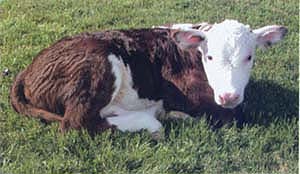All Issues
Cloned calf “Rosie” is rosy
Publication Information
California Agriculture 56(4):117-117.
Published July 01, 2002
PDF | Citation | Permissions
Full text
A cloned Hereford calf named Rosie is doing well after its birth at UC Davis on May 2.
The reddish-brown and white female is part of an ongoing study-aimed at better understanding which types of adult cells are best suited for cloning cows. The researchers hope to improve the cloning technique, eventually using it to produce more healthful meat and milk products.
"We're encouraged that Rosie is feeding well and acting energetic like any other newborn calf,” says Gary Anderson, professor and chair of the UC Davis animal science department. However, because young calves are especially vulnerable to respiratory, digestive and umbilical infections, scientists continue to watch her closely.
The calf was cloned from a follicle cell taken from the ovary of a 16-year-old, reddish-brown Hereford cow, and has the same coloring and markings as the cow from which she was cloned.
This is the second calf cloned and delivered at UC Davis. The first was born in August 2001 and died three days later due to multiple birth defects. Worldwide, an estimated 150 cloned calves have been born at about 10 laboratories.
The new calf is expected to remain at UC Davis for about 2 months, then go to a Northern California ranch where the cow from which she was cloned lives.
Cloning may someday enable scientists to produce replicas of individual animals that have valuable traits, such as cows whose milk is particularly nutritious. Cloning could also be used to genetically engineer cows and sheep that can produce pharmaceuticals in their milk.
The current technology used to produce clones in the laboratory, called nuclear transfer, involves removing the nucleus (with its genetic material) from the unfertilized egg cell of one cow. Then a cell is taken from somatic tissue of a donor animal of the same species and placed next to the “empty” egg. In this case the donor cell was a follicle, supportive tissue in the cow's ovary.
An electrical charge is applied, causing the two cells to fuse together. The fused egg is placed in a lab dish with the appropriate nutrients. Eventually the resulting embryo — which is a genetic copy of the animal that donated the nucleus — is transplanted into a surrogate mother.





